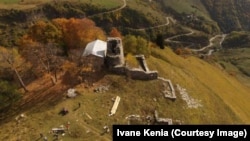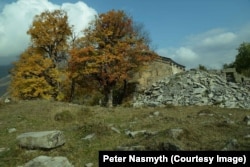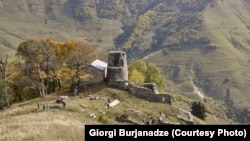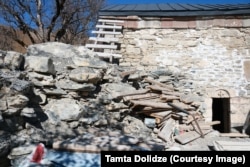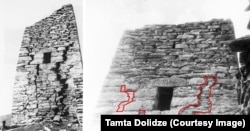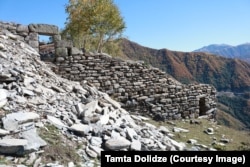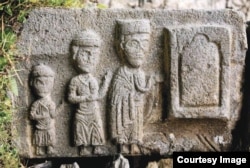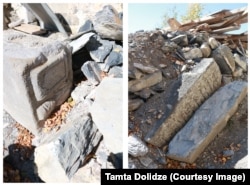In Georgia, there are roughly 8,000 cultural heritage monuments, of which 1,000 have earned the distinction of being designated as national monuments. Among them is the 10th-century Korogho tower, bestowed with this honor by presidential decree. It is now a mound of rubble awaiting restoration.
Historians, conservators, and art critics are horrified by its demise. They argue that, even if reconstruction is possible, the irreversible damage done would alter its 10th-century authenticity. The project managers claim that the tower's destruction was simply the start of its reconstruction process.
The public only became aware of this by happenstance when a photograph taken on October 8 by British photographer Peter Nasmyth revealed the destruction at Korogho, which lies adjacent to a historic church complex.
Nasmyth, the founder of the National Foundation in Britain and an advocate of hiking tourism in Georgia, tells RFE/RL that during a hike in the Khada Valley with a group tasked with showcasing Georgia's important architectural monuments, he was left speechless by what he had seen. It was his daughter who first pointed to the hill, now occupied by ruins instead of the tower.
After his return to Tbilisi, Nasmyth compared the recent photo of Korogho to the one he had captured a year ago, which had been previously shared on the Internet.
"This is shocking and terrible! The Khada Valley was not lacking in problems, but to destroy a monument of national importance is an unbelievable tragedy!" Nasmyth said.
Perched high above the village of Midelaurta, Korogho is situated on the slope of a lofty mountain, nestled on the precipice of a rocky cliff known for its natural splendor. Next to the former tower stands the Church of the Virgin Mary.
There are about 8,000 cultural heritage monuments cultural heritage monuments in Georgia, and only 1,014 of them have the status of national monuments. This designation is reserved for structures of exceptional artistic, historic, or national significance. The prestigious status was conferred upon the Korogho complex through a presidential decree.
Locals rule out the likelihood that the tower was destroyed by a tractor, bulldozer, or another type of vehicle. It is almost impossible to transport huge machinery to the church and tower due to its position atop a very steep mountain.
A week after the images were posted online, Georgia's Cultural Heritage Agency and the Ministry of Culture have yet to offer an explanation for the demolition of the Korogho tower, including details on the method employed and whether it was linked to a restoration project.
According to several employees, the decision to demolish the tower was based on concerns that it posed a threat to the neighboring church. They also claim that the tower is not an authentic 10th-century structure but rather a recent, inauthentic monument constructed in the last century.
In response, art critic Tamta Dolidze published photos taken in 1952 and 1993 of Korogho. The first photo shows cracks, whereas the second one only shows traces of the cracks.
"In the first photo you can see the large cracks, and in the second photo you can easily see the very fine shale inlays. If the tower were to be dismantled and rebuilt, naturally, the places of the cracks would not be preserved, nor would it be necessary to fill them with thin slate," Dolidze said.
"If we call all the restored monuments inauthentic, we should raze Svetitskhoveli Cathedral and the church of Tsromi to the ground, as they are not authentic either," he explains.
Dolidze traveled to the Korogho complex to see the damage for himself. In addition to the destruction of the tower, he is also very concerned about the restoration work in the church, which is being carried out with questionable methodology and quality.
As for the tower, Dolidze does not believe that it will be rebuilt correctly.
"The monument no longer exists, and we must understand why such an extreme decision was made. We cannot turn back time, but it is very important that the dismantling and assembling of monuments does not become an accepted practice of rehabilitation."
During the restoration work carried out in 1954, the tower was recognized as the complex's oldest building. Based on this documentation it was declared a national monument.
A copy of the original documentation shows that the status of the church is assessed as "severe," while noting that the tower is the oldest building in the complex.
The contract for the restoration of the church was given to Paata Kurtanidze in 2019. Kurtanidze was paid 37,700 Georgian Lari (roughly $14,000) for the undertaking. He has declined to respond to inquiries from RFE/RL.
Nana Mefarishvili, an architect and researcher, told RFE/RL that the destruction was unwarranted.
"Of course, [the tower] was damaged, but there was no need for it to be dismantled in such a hasty and unprofessional manner," she said. "The monuments were one meter apart, and the worst thing that could happen was that a stone falling from the tower could hit the roof of the church," Mefarishvili added.
Mefarishvili has worked on a number of important restoration projects, including the restoration of Mutso in Khevsureti. She explains that, when a building collapses, proper accounting is of the utmost importance.
"When removing the stones, meticulous photo documentation as well manually drawn and numbered pieces are documented so that they can be returned to their original location. This was not done here," Mefarishvili said.
The most significant stone from Korogho depicts the church builders holding a plan of the church's construction, a highly unique scene. In addition to being a recognizable outlier for Georgian architecture and iconography, "Builders with a plan" is also unmatched worldwide.
"If any illustration of medieval Georgian art is used in Western publications, one of them is the reliefs of Korogho. Ironically, the Korogho manifesto from a millennium ago -- which said that events must progress according to plan -- was broken there," wrote Irine Giviashvili, an art historian and employee of the Chubinashvili National Center on Facebook.
Archaeologist, Giorgi Gogochuri, who photographed the site in 2013, also believes that the cracks could have easily been repaired. "What happened to this tower is a criminal offense, and everyone who did it should be punished," he adds.
Georgia's Criminal Code states that destroying or causing damage to cultural property carries a fine or a maximum two-year jail sentence. When a monument of national significance is intentionally damaged, the penalty is enhanced to two to four years in prison, and when the monument is destroyed, the punishment is extended to four to eight years.
According to statistics provided by the Ministry of Internal Affairs, inquiries into allegations of damage to cultural property never lead to the identification and punishment of the perpetrators. Out of the 75 incidences of damage reported between 2017 and 2022, only seven were looked into.
"They will continue [to destroy monuments] if there is no response to this right now," she adds. "When it comes to cultural heritage, everything is broken; there is no mechanism, no fines, no accountability for crime, no accountability for poor work," Mefarishvili told RFE/RL.
The Khada Valley, also known as the Valley of the 60 Castles (Tsikhegoji) for its famed rock formations, which are believed to have been used for various purposes, including dwellings, fortifications, and places of worship, is also home to many secret hideouts for treasure.
For example, an 11th-century ivory icon of the Virgin Mary, a cross with the image of the Savior, and engraved plates found in the hideout of the Korogho complex are now part of the National Museum's collections.
The state refuses to discuss the status of the other monuments in the Khada Valley and whether there are any plans for future restorations.
Another threat to the cultural heritage of the Khada Valley is the new highway connecting Georgia with Russia. Environmentalists and cultural heritage specialists are especially concerned about blasting work and other engineering activities undertaken to build the roadworks, which could potentially lay waste to some of Georgia's natural and cultural heritage.
Unfortunately, for the Khada Valley, a list of important sites has never been drawn up, nor have these areas been properly surveyed by archaeologists.




